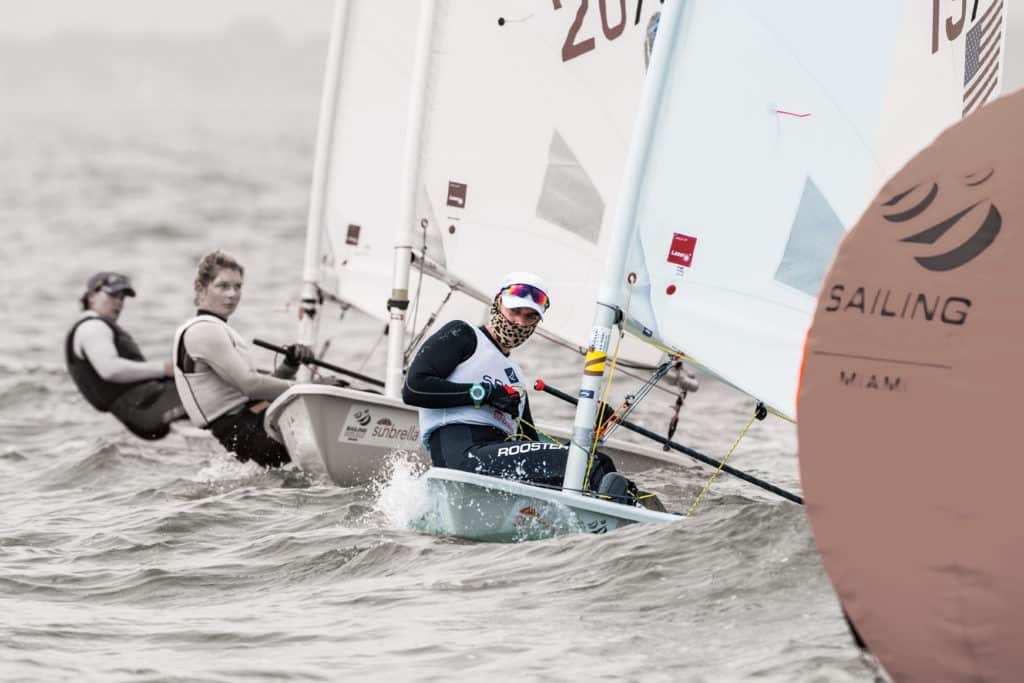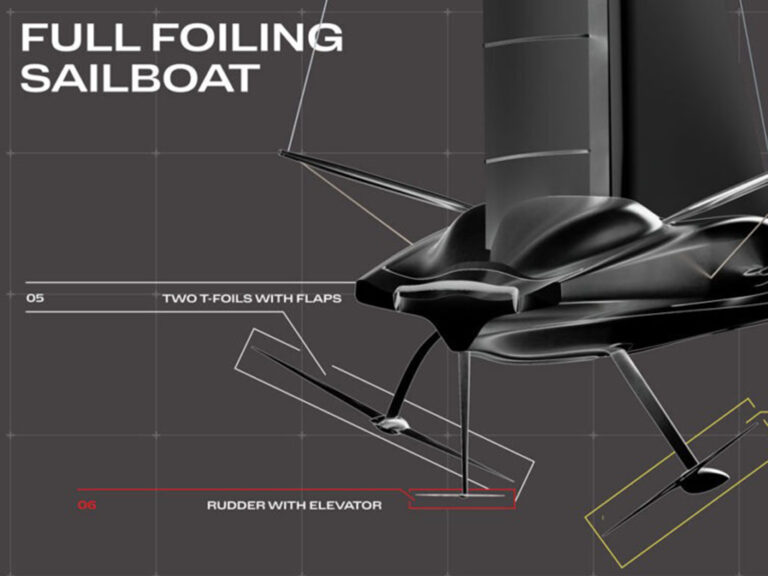
Her Olympic story is perfectly scripted. It’s a Bob Costas heart-tugging short about a gorgeous, icy-blue-eyed athlete rising to meet her greatest personal challenge. The narrative starts the moment she’s head over the handlebars of her road bike, face smacking and sliding across hot Florida asphalt at 20 miles an hour. The impact rattles her brain, breaks her spine, and wrecks her nerves and knuckles. But it doesn’t break her drive.
Roll the cliché: What didn’t kill her most definitely made her stronger. Yesterday she was crumpled roadside. Today she’s looking at her second earned Olympic appearance, this time as a better, faster, humbler Paige Railey.
It’s predictable to pin the 30-year-old Laser Radial sailor’s story on her physical and mental return to form, but there’s so much more to it. There are preceding chapters filled with character-building victories and upsets. It’s a long story, one that reaches back to the International Optimist Dinghy kiddie circuit, which shaped Railey into the US Sailing Team’s most intriguing personality.
Her social-media feed confirms she’s still true to her girlish ways while maturing past 30 years. Her interests outside the gunwales of the 14-foot sailboat on which she has spent 15 immersive years include fashion (South Florida style), travel (everywhere), fishing (she’s apparently pretty good), working out (#girlswithmuscle), and selfies with family members and a tight inner circle. And there are mentions of Rio, of course. Now that Railey has earned the berth, the definitive goal is there for the taking. “I’ve learned what it means to fight and to come from the bottom and work my way back up — and that’s very hard,” she says, “especially because I know where I used to be, and trying to get back up there is very difficult.”
In the days before her accident in the summer of 2014, Railey was headlong into her third Olympic campaign, going through the motions with her devoted coach, Mark Littlejohn. She was focused on the world championships. Then came pavement, the flash, the ambulance, the ER, the doctors, the pain, the lesions, the nausea, the darkness and the doubts. She was intent on sailing immediately, but her brain — and her doctors — wouldn’t allow it. They wrote her off for six months, minimum.
“Dry heaving, dizzy, not able to make sense of anything, and slurring” is how she describes her miserable existence. “I was a zombie. It was the worst feeling ever.”
At six weeks, she attempted to resume training. It was a mistake. “I wasn’t the same person,” she told Sailing Scuttlebutt. “I was the girl in the pink helmet determined to feel normal again.” Her first day back in the boat was in Rio, and she was “really terrible.”
“That day was humbling. I sailed with the Brazilian team, and after about 30 minutes of practice, one of the coaches had to pull me onto their boat and hold me upright because I was so dizzy. “I was like, ‘Wow. Look where I am. I’ve gone from being the best in the world to not being able to sit upright.’”
Witnessing firsthand her humiliating return to international sailing was her new training partner, Henry Marshall, a 16-year-old Radial whiz kid from Massachusetts. At half her age, and possessing a fraction of her worldly sailing experience, Marshall is said to have contributed to Railey’s return to the top as much as anything else.
They first started working together in November 2015, at the time Railey returned from the accident. “She was having trouble with simple things like grabbing the rail in a tack,” says Marshall, who dropped out of school to join US Sailing’s Olympic Development Program. “It was a lot of headaches and back pain. I could see it was tough for her, but I saw her attitude and resilience.” She’d fight through long and windy days and push her limits, he says. She had to prove she could overcome the accident. “That set the tone that we were there for business and knowing we were going to do whatever it took to make Paige better,” he says. “She felt people felt bad for her, and she didn’t want that. She didn’t want sympathy; she just wanted to get back at it.” While Marshall will assuredly reap the fruits of training alongside America’s most experienced Radial sailor, Railey benefited equally from the partnership. She had to relearn the fundamentals, and Marshall was the one who helped reinforce them.

The biggest thing between them, she says, is loyalty. “I’ve found that a lot of people are out for things that only benefit themselves, and our relationship is not just about what I can get from this kid to improve my sailing, but how I can help him. For the first time, I have a true training partner and a friend.”
The early stages of their work in Rio were focused on acclimating to the venue’s split personality. It’s flat and swirly on the inside, and it’s big ocean swells and frothy whitecaps on the outside. Marshall recalls their first windy training day outside as “inspirational.”
“We were just working on upwind speed. It was our fourth really windy day, the miserable sort of days of Laser sailing with a lot of hiking,” he says. “We’d done the gym in the morning, and Paige was the one telling me I had it in me when I was at my limit. I know she was pushing herself three times more.”
Today, Railey says, Marshall is the one doing the pushing: “That boy will work. He doesn’t like to lose.”
And neither does she, a character flaw that has been her undoing in pressure situations. Sketchy tactics and a long rap sheet of kinetic violations from unpredictable on-the-water umpires have derailed her numerous times. But the accident, she says, has made her more philosophical and quieted the voices in her head.
“I’m just enjoying life and putting my heart into everything I have,” she says. “Last year I got a lot of fourths and eighths at events. I’d be top three but get too excited and start telling myself, ‘Finally, I’m here,’” she says. “Then I would mess up a race.”
She never doubted her sailing ability. She knew she could get back there. The mental side — could she get to 100 percent? — was the great unknown. “A lot of it was overstimulation,” she says. “My brain would get overexcited.”
A silver medal at the Laser Radial Worlds in Puerto Vallarta, Mexico, in April, the last big event before the Big One in August, was precisely the validation she needed to cement her born-again status at the top of the Olympic Radial heap.
“It really helped her out,” says Marshall, “because it was an accumulation of all the suffering of the last few years and beyond. To bring it all together before the Games, that’s special. She and Mark have been working extremely hard on connecting all the pieces, and they have them. She’s sailing the best she’s sailed in years.” So there it is, Paige Railey’s made-for-TV story served on a silver platter to Mr. Costas’ producers at NBC. Here’s a champion of her sport, one who fell hard from the mountaintop but slogged to its summit again. She was broken and is now repaired. In her mind, fragile as it is, only a gold medal will wipe away the suffering and replace it with something she can have for the rest of her life — an amazing result in Rio. It’s what she wants the most, says Marshall, and she will do anything to get it.









